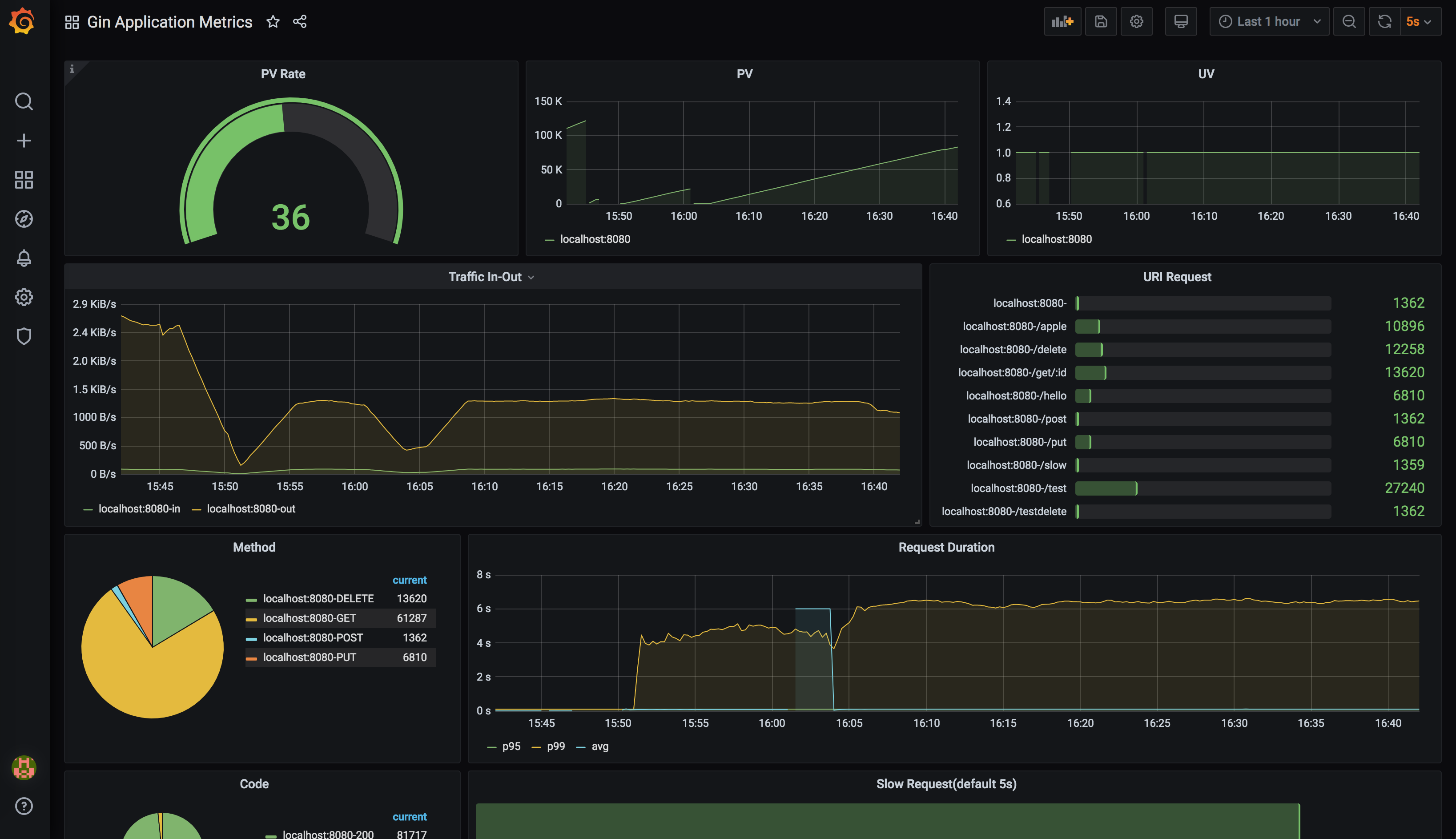gin-gonic/gin metrics exporter for Prometheus.
gin-metrics defines some metrics for gin http-server. There have easy way to use it.
Below is the detailed description for every metric.
| Metric | Type | Description |
|---|---|---|
| gin_request_total | Counter | all the server received request num. |
| gin_request_uv | Counter | all the server received ip num. |
| gin_uri_request_total | Counter | all the server received request num with every uri. |
| gin_request_body_total | Counter | the server received request body size, unit byte. |
| gin_response_body_total | Counter | the server send response body size, unit byte. |
| gin_request_duration | Histogram | the time server took to handle the request. |
| gin_slow_request_total | Counter | the server handled slow requests counter, t=%d. |
Set the grafana directory for details.
$ go get github.com/yluchao/gin-metricsYour can see some metrics across http://localhost:8080/metrics
package main
import (
"github.com/gin-gonic/gin"
"github.com/yluchao/gin-metrics/ginmetrics"
)
func main() {
r := gin.Default()
// get global Monitor object
m := ginmetrics.GetMonitor()
// +optional set metric path, default /debug/metrics
m.SetMetricPath("/metrics")
// +optional set slow time, default 5s
m.SetSlowTime(10)
// +optional set request duration, default {0.1, 0.3, 1.2, 5, 10}
// used to p95, p99
m.SetDuration([]float64{0.1, 0.3, 1.2, 5, 10})
// set middleware for gin
m.Use(r)
r.GET("/product/:id", func(ctx *gin.Context) {
ctx.JSON(200, map[string]string{
"productId": ctx.Param("id"),
})
})
_ = r.Run()
}gin-metric provides ways to custom your own metric.
With Gauge type metric, you can use three functions to change it's value.
And you should define a Gauge Metric first,
gaugeMetric := &ginmetrics.Metric{
Type: ginmetrics.Gauge,
Name: "example_gauge_metric",
Description: "an example of gauge type metric",
Labels: []string{"label1"},
}
// Add metric to global monitor object
_ = ginmetrics.GetMonitor().AddMetric(gaugeMetric)SetGaugeValue
SetGaugeValue will setting metric value directly。
_ = ginmetrics.GetMonitor().GetMetric("example_gauge_metric").SetGaugeValue([]string{"label_value1"}, 0.1)Inc
Inc will increase 1 to metric value
_ = ginmetrics.GetMonitor().GetMetric("example_gauge_metric").Inc([]string{"label_value1"})Add
Add will add float64 num to metric value
_ = ginmetrics.GetMonitor().GetMetric("example_gauge_metric").Add([]string{"label_value1"}, 0.2)With Counter type metric, you can use Inc and Add function, don't use SetGaugeValue.
For Histogram and Summary type metric, should use Observe function.
For some users, they don't want to merge the port of the metric with the port of the application.
So we provide a way to separate the metric port. Here is the example.
func main() {
appRouter := gin.Default()
metricRouter := gin.Default()
m := ginmetrics.GetMonitor()
// use metric middleware without expose metric path
m.UseWithoutExposingEndpoint(appRouter)
// set metric path expose to metric router
m.Expose(metricRouter)
appRouter.GET("/product/:id", func(ctx *gin.Context) {
ctx.JSON(200, map[string]string{
"productId": ctx.Param("id"),
})
})
go func() {
_ = metricRouter.Run(":8081")
}()
_ = appRouter.Run(":8080")
}If someone has a problem or suggestions, you can submit new issues or new pull requests.
